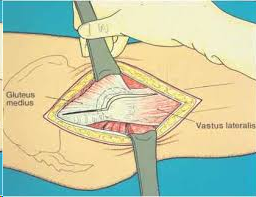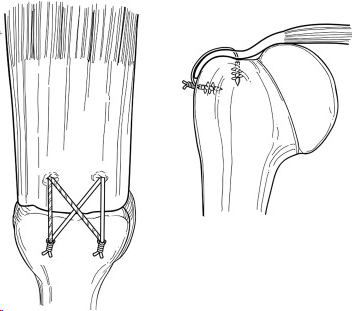Gluteus Tendon Tear
What is Gluteus Tendon Tear?
The gluteus medius and minimus muscles are responsible for lifting the hip sideways.
A gluteus tendon tear is a condition in which the tendon that attaches the gluteus medius and minimus muscle to the femur tears, either partially or completely. The tear can range from a mild strain to a complete rupture and can cause significant pain and discomfort in the side of the hip.
How Does Gluteus Tendon Tear Impact Your Anatomy and Health?
A gluteus tendon tear can cause significant pain and discomfort.It can cause limping . It can also limit the range of motion in the hip joint and make it difficult to perform activities such as walking, running, or climbing stairs.
Who is Most at Risk for Gluteus Tendon Tear?
Gluteus tendon tears are most commonly seen in middle-aged or older adults who are active or participate in sports that require repetitive hip motion, such as running, jumping, and kicking. People with a history of hip surgery or previous hip injuries are also at higher risk.
Causes of Gluteus Tendon Tear
- The most common cause of gluteus tendon tears is repetitive stress on the tendon due to overuse. This can occur in individuals who engage in repetitive hip motion activities, such as long-distance running, soccer, or ballet dancing.
- Trauma, such as a fall, can also cause a tear in the gluteus tendon. Sudden forceful contraction of the gluteus muscle can also cause a tear.
- People with underlying medical conditions such as rheumatoid arthritis, osteoporosis, or obesity are at higher risk of developing a gluteus tendon tear.
- In some cases, the tear can occur due to degeneration of the tendon over time, especially in older adults.
Symptoms of Gluteus Tendon Tear
The symptoms of a gluteus tendon tear may vary depending on the severity of the tear. The most common symptoms include:
- Pain and tenderness in the hip and buttock region, which may worsen with activity or when sitting for long periods
- Weakness in the affected leg, which can make it difficult to walk or stand up from a seated position
- Difficulty performing activities that involve hip movement, such as running, climbing stairs, or bending over
- Swelling and bruising around the hip area
- A popping or snapping sound at the time of the injury
Types of Gluteus Tendon Tear
- Partial Tears: Involves only a portion of the tendon fibres. Partial tears may not completely sever the tendon and can sometimes be treated with conservative measures such as rest, ice, and physical therapy.
- Complete Tears: Involves a complete severance of the tendon fibres, resulting in a loss of function of the gluteus maximus muscle. Complete tears usually require surgery to reattach the tendon to the femur and restore function to the muscle.
Stages of Gluteus Tendon Tear
- Stage 1: Mild inflammation and microscopic tearing of the tendon fibres. This stage is typically characterised by minor pain and discomfort in the hip and buttock region. The tear may not be noticeable in imaging studies such as X-rays or MRIs.
- Stage 2: Partial tearing of the tendon fibres. This stage may result in moderate to severe pain and difficulty with hip movement activities. Imaging studies such as MRI may show partial tearing of the tendon.
- Stage 3: Complete tearing of the tendon fibres. This stage is characterised by severe pain, weakness in the affected leg, and a loss of function of the gluteus maximus muscle. Imaging studies such as MRI may show a complete severance of the tendon fibres.
Gluteus Tendon Tear Diagnosis
To diagnose a gluteus tendon tear, your orthopaedic surgeon will begin with a physical examination to assess the hip joint's range of motion and strength. Your doctor will look for signs of tenderness, swelling, and bruising in the hip and buttock region. They may also ask about your medical history and any previous injuries to the hip.
Your doctor will need to diagnose the specific nature of your hips disorder or the extent of any other conditions that may be related.
A clinical diagnosis is made by:
- Taking a Medical History
- Performing a Medical Examination
- Range of Motion Assessment
- Pathology Testing, but there is no blood test for osteoarthritis
To clearly understand the nature of the condition, imaging scans may be required:
- X-rays: Do not show cartilage but are often taken as they can help rule out other problems with the hip that may have similar symptoms like fractures (broken bone), joint space, bony spurs and arthritic cysts.
- MRI: Create detailed images of hard and soft tissues within your hip. An MRI can produce cross-sectional images of internal structures required if the diagnosis is unclear or if other soft tissue injuries are suspected, such as ligament injuries, articular cartilage wear, and labral tears.
- Ultrasound: Allows the doctor to examine the inside of your hip in motion. This can help determine if you have a loose flap of cartilage getting caught between the moving parts in your hip.
While not all of these approaches or tests are required to confirm the diagnosis, this diagnostic process will also allow your doctor to review any possible risks or existing conditions that could interfere with the surgery or its outcome.
Gluteus Tendon Tear Treatment
The treatment options for a gluteus tendon tear will depend on the severity of the tear. Below are some of the most common treatment options for gluteus tendon tears:
- Rest and Physical Therapy: For mild tears, rest and physical therapy may be sufficient to relieve symptoms and promote healing. The physical therapist may recommend exercises to strengthen the hip muscles and improve flexibility and other modalities such as ultrasound or electrical stimulation.
- Medications: Nonsteroidal anti-inflammatory drugs (NSAIDs) such as ibuprofen or naproxen may be prescribed to relieve pain and reduce inflammation.
- Corticosteroid Injections: Corticosteroid injections may reduce inflammation and pain in the hip joint.
- Surgery: For severe tears, surgery may be necessary to repair or reattach the tendon to the femur. The surgeon may perform open surgery or minimally invasive arthroscopic surgery, depending on the extent of the tear.
- Assistive Devices: In some cases, assistive devices such as crutches or a cane may be necessary to relieve pressure on the hip joint and reduce pain during walking or other activities.
Gluteus Tendon Tear Prevention
While it may not be possible to prevent all cases of gluteus tendon tears, some steps can be taken to reduce the risk of developing this condition. Some prevention tips include:
- Warm up before exercising: Before engaging in any physical activity, it is important to warm up and stretch the muscles to reduce the risk of injury.
- Avoid overuse: Engaging in repetitive activities such as long-distance running, jumping, or kicking can stress the gluteus tendon and increase the risk of developing a tear. It is important to incorporate rest days into the exercise routine and to avoid overtraining.
- Maintain a healthy weight: Excess weight can add stress to the hip joint and increase the risk of developing a gluteus tendon tear. Maintaining a healthy weight can help to reduce this risk.
- Wear proper footwear: Wearing shoes with good support and cushioning can help to reduce the stress on the hip joint during physical activity.
- Listen to your body: Pay attention to any signs of pain or discomfort in the hip region and seek medical attention if symptoms persist.
Surgical management of Gluteal tendon tear

The tear is approached through an incision on the side of the hip (similar to a Hardinge approach).The tear edges are then freshened and any degenerate areas removed to enable healing.The tendon is sutured back to the area where it was lifted off from and allowed to heal over a period of time.
The method of repair ,adapted from tendon repair in the shoulder, is the double row Speed Bridge repair using small screw like devices called anchors and nonabsorbable material called Fiberwire made of polyester. This repair is thought to be more robust because it provides a wide area of re-attachment of the tendon and not just on the cut edge. (see figure below)

This repair is thought to be more effective in giving the tendon more time to heal without disruptive forces at the suture as with the usual method of repairing side to side.
A repaired tendon may appear satisfactory but that does not mean we can reverse any of the age related changes that may have taken place and contribute to the overall symptoms.
What if Gluteus Tendon Tear is Untreated?
If left untreated, a gluteus tendon tear can lead to chronic pain, weakness, and instability in the hip joint. It can also increase the risk of developing other hip conditions, such as bursitis or tendinitis. In severe cases, untreated gluteus tendon tears can lead to permanent disability and loss of function.



